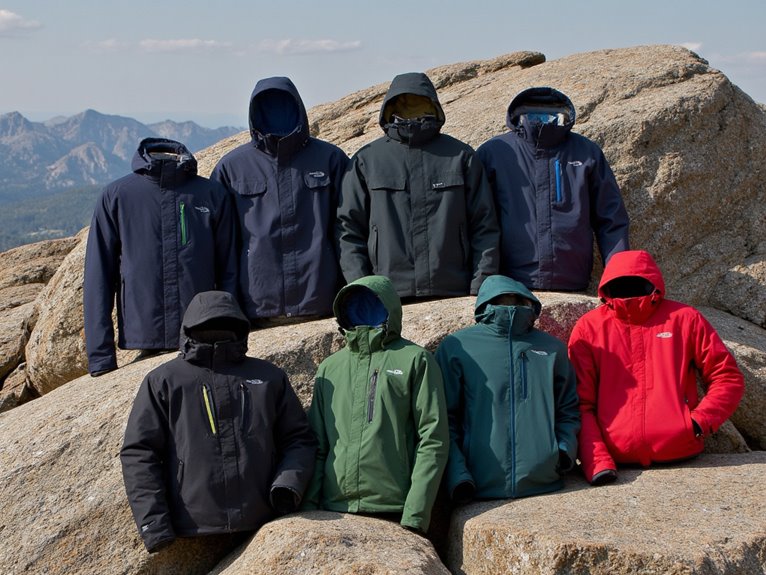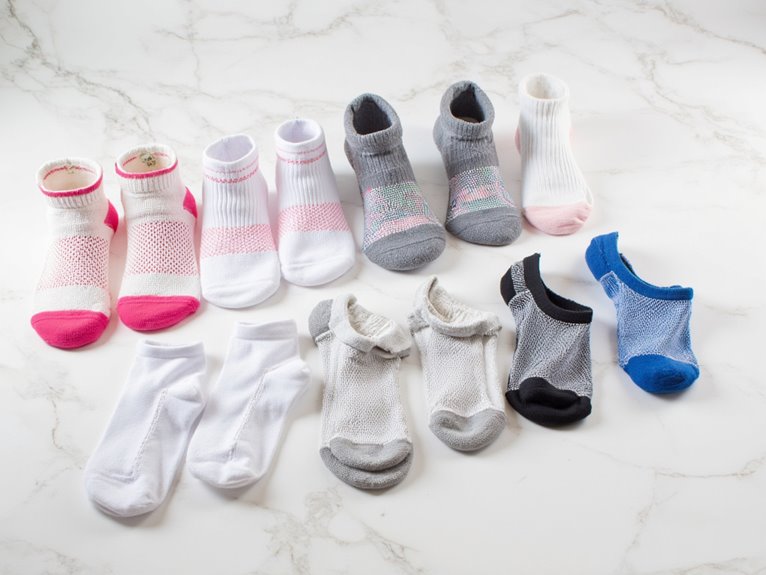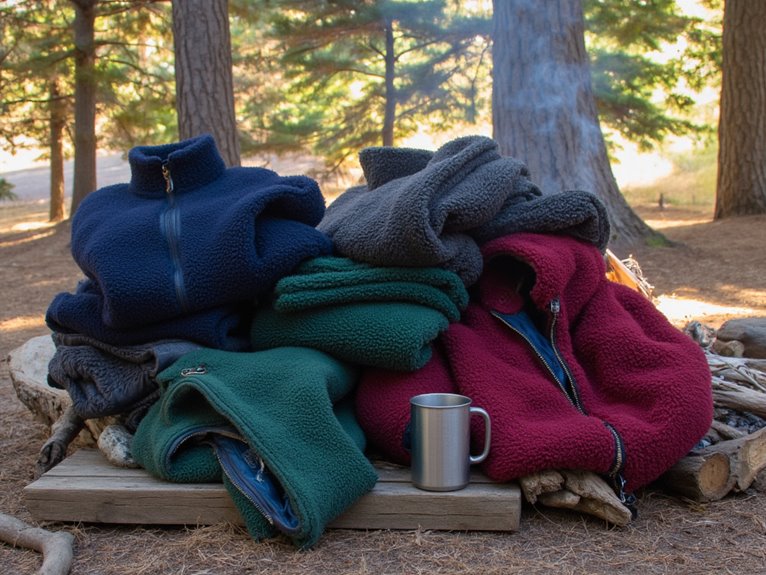10 Best Base Layers for Hiking That Will Keep You Comfortable on Any Trail
After testing dozens of base layers, I’ve found that merino wool consistently outperforms synthetics for temperature regulation and odor resistance. MERIWOOL’s lightweight options excel for active hiking, while Carhartt’s 200 GSM polyester provides superior durability. For freezing conditions, I recommend heavier fabrics above 150 GSM, but lighter weights work best above 40°F. The complete breakdown of each layer’s performance characteristics reveals essential details for your specific hiking conditions.
We are supported by our audience. When you purchase through links on our site, we may earn an affiliate commission, at no extra cost for you. Learn more. Last update on 18th December 2025 / Images from Amazon Product Advertising API.
Notable Insights
- Choose merino wool base layers for superior temperature regulation, moisture-wicking, and natural odor resistance during multi-day hikes.
- Select lightweight fabrics under 150 GSM for active conditions and heavier weights for freezing temperatures below 40°F.
- Consider synthetic polyester options with elastane for enhanced durability, faster drying, and improved stretch during dynamic movements.
- Look for key features like covered waistbands, tagless labels, and FastDry technology to prevent chafing and maximize comfort.
- Follow proper care instructions including regular washing, avoiding fabric softeners, and air drying to maintain performance longevity.
MERIWOOL Men’s Base Layer Bottoms – Lightweight Merino Wool Thermal Pants
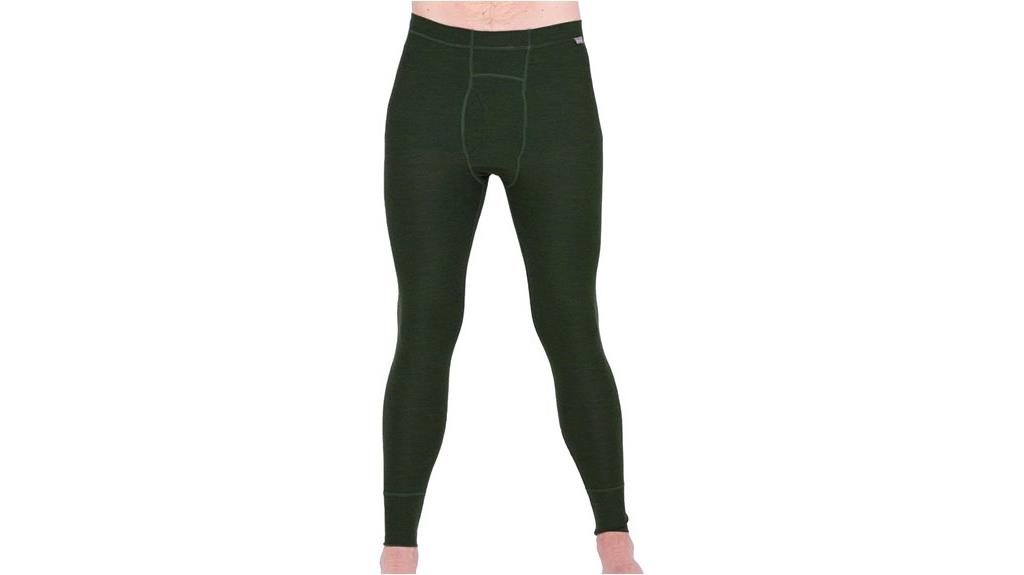
The MERIWOOL Men’s Base Layer Bottoms target hikers who need versatile thermal wear that shifts seamlessly from trail to daily activities. You’ll find these lightweight merino wool thermal pants deliver excellent warmth-to-weight ratios for cold-weather hiking. The merino wool construction provides natural odor resistance, letting you wear them multiple days without washing.
The covered waistband design eliminates pressure points during long hikes with heavy packs. You can layer these bottoms under hiking pants or wear them as standalone trail wear in warmer conditions. However, durability issues at stress points may concern frequent users who need gear lasting multiple seasons. Some hikers report seam discomfort with tight boots.
Best For: Hikers and outdoor enthusiasts who need lightweight, versatile thermal base layers that can transition from trail activities to daily wear while providing natural odor resistance and warmth in cold conditions.
Pros:
- Excellent warmth-to-weight ratio with natural merino wool odor resistance for multi-day wear
- Versatile design suitable for layering under hiking pants or wearing as standalone trail wear
- Comfortable covered waistband eliminates pressure points during long hikes with heavy packs
Cons:
- Durability issues at stress points with wear and tear reported within a month of use
- Seam discomfort when worn with tight boots during activities like skiing
- Poor customer service experience with cumbersome process for resolving product issues
Mens 100% Merino Wool T-Shirt, Breathable Base Layer
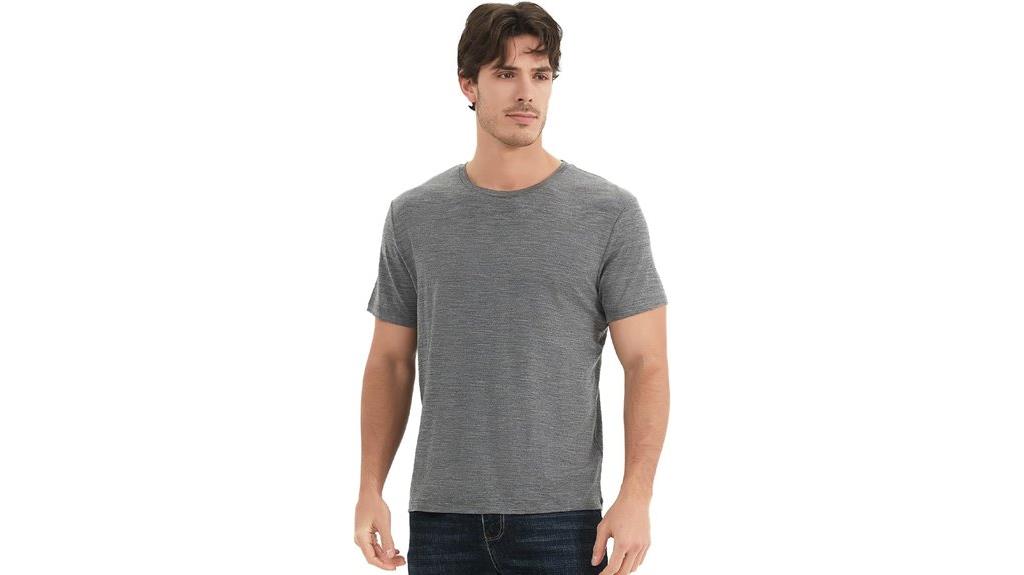
Merino wool’s natural temperature regulation and moisture-wicking properties make this 100% merino wool base layer an ideal choice for hikers who prioritize comfort across varying weather conditions. You’ll find the fabric remarkably soft and non-scratchy, resembling premium cotton while delivering superior performance. The shirt maintains a form-fitting silhouette without clinging to your skin during active movement.
Sizing runs true to standard measurements. You can wear this versatile piece as a standalone shirt for casual hiking or layer it under jackets during colder conditions. The lightweight construction won’t add bulk to your pack.
Care requires attention to detail. Machine wash on delicate cycles with cold water to prevent shrinkage. At $40, the premium pricing reflects the quality merino wool construction and multi-season functionality you’ll experience on diverse trails.
Best For: Hikers and outdoor enthusiasts who want a versatile, high-quality merino wool base layer that can function as both standalone casual wear and layering piece for varying weather conditions.
Pros:
- 100% merino wool fabric offers superior temperature regulation, moisture-wicking, and soft non-scratchy comfort that feels luxurious against skin
- Versatile design works as both a standalone shirt for casual activities and an effective base layer for colder weather hiking
- True-to-size fit with form-fitting silhouette that doesn’t cling during active movement while maintaining a flattering appearance
Cons:
- Premium pricing at $40 makes it a significant investment compared to synthetic alternatives
- Requires careful washing with delicate cycles and cold water to prevent shrinkage and maintain fabric integrity
- Collar may lose elasticity and durability after multiple washes, potentially affecting long-term appearance
MERIWOOL Mens Merino Wool Long Sleeve Thermal Base Layer Shirt
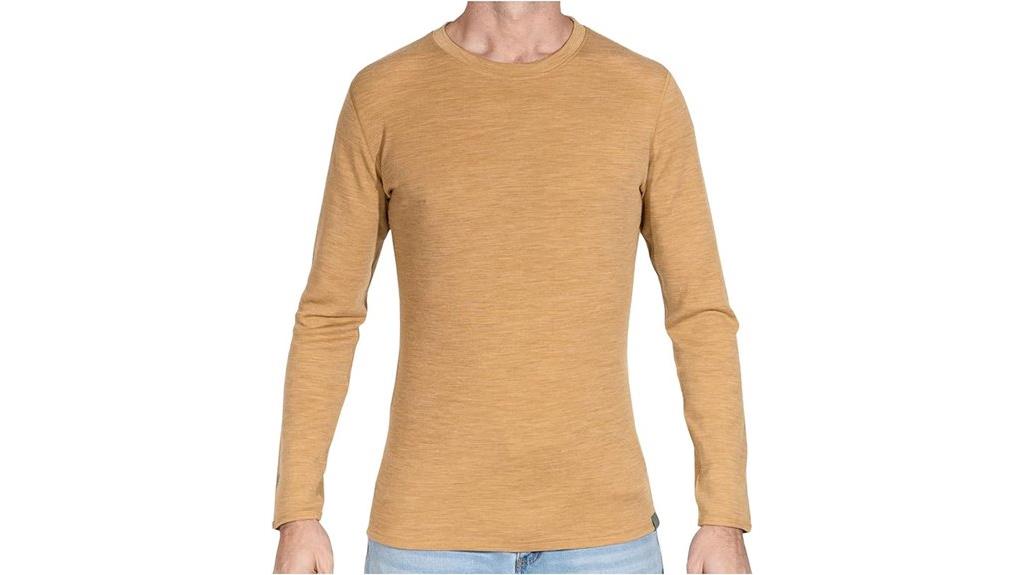
Hikers seeking reliable thermal regulation in fluctuating mountain conditions will find exceptional value in MERIWOOL’s 100% merino wool midweight thermal shirt. This versatile base layer functions effectively as both underwear and outer garment depending on weather conditions. The natural wool fibers provide warmth retention while maintaining breathability during active hiking.
You’ll appreciate the shirt’s soft, non-itchy construction that accommodates various body types comfortably. Care requirements remain minimal—wash in cold water using a mesh bag, then air dry on a hanger. The fabric resists shrinking and maintains color integrity through multiple wash cycles.
Sizing runs variable, with Large offering extra length in sleeves and torso for extended coverage.
Best For: Hikers and outdoor enthusiasts who need a versatile thermal base layer that provides warmth and breathability in changing weather conditions.
Pros:
- 100% merino wool construction offers natural warmth retention and breathability without being itchy
- Versatile design functions effectively as both a base layer and outer garment depending on conditions
- Easy care with cold water washing, air drying, and resistance to shrinking while maintaining color integrity
Cons:
- Sizing runs inconsistent with some customers finding Large excessively long while others prefer the extra length
- Limited color options available compared to synthetic alternatives
- Higher price point than synthetic thermal base layers
Thermajohn Long Johns Thermal Underwear for Men Fleece Lined Base Layer Set

Fleece-lined construction sets the Thermajohn Long Johns apart for hikers who prioritize warmth without bulk in freezing conditions. The stretchy fabric maintains its shape without sagging while delivering exceptional thermal performance well below freezing temperatures. You’ll find the firm-fitting design keeps warmth close to your body without restricting movement on challenging trails.
The waistband stays positioned during active use, preventing cold spots that compromise comfort. This base layer works effectively under hiking pants and additional layers, though you may find yourself overheating in moderate temperatures due to its high thermal efficiency. The fabric resists shrinking and maintains shape through repeated washing cycles, ensuring long-term durability for extended hiking seasons.
Best For: Hikers and outdoor enthusiasts who need reliable thermal base layers for cold weather activities without the bulk that restricts movement.
Pros:
- Exceptional warmth-to-bulk ratio with fleece-lined construction that performs well in freezing temperatures
- Stretchy, firm-fitting design maintains shape without sagging while allowing full range of motion
- Durable fabric resists shrinking and maintains performance through repeated washing cycles
Cons:
- May cause overheating when worn in moderate temperatures or under multiple layers
- Some users report minor cosmetic issues like pilling after initial use
- High thermal efficiency can make temperature regulation challenging in varying conditions
Thermajohn Thermal Shirts for Men Long Sleeve Base Layer

Budget-conscious hikers who need occasional warmth will find the Thermajohn Thermal Shirts for Men Long Sleeve Base Layer delivers essential insulation without breaking the bank. You’ll get adequate warmth retention for moderately cold conditions and early morning trail starts. The breathable fabric maintains comfort during active hiking while providing light compression that’s suitable for layering under hiking jackets.
However, you should expect durability issues after several washes. The material develops pilling, loose threads, and reduced stretch over time. Some users report stitching problems and fleece bubbling after minimal use. Size M fits like US size S but remains stretchable. You’ll find sleeve length slightly short for some body types. Consider this base layer for occasional hiking rather than heavy trail use.
Best For: Budget-conscious hikers who need occasional warmth and light insulation for moderately cold conditions and early morning trail starts.
Pros:
- Provides adequate warmth retention and breathable comfort during active hiking
- Budget-friendly option with comfortable compression suitable for layering under jackets
- Soft fabric that requires no ironing and maintains comfort for occasional use
Cons:
- Develops durability issues after several washes including pilling, loose threads, and reduced stretch
- Size M fits like US size S with slightly short sleeve length for some body types
- Quality problems emerge quickly including stitching unraveling and fleece bubbling after minimal use
Carhartt Mens MBL113 Base Force® Midweight Base Layer Classic Crew

The Carhartt Mens MBL113 Base Force® Midweight Base Layer Classic Crew targets outdoor enthusiasts who demand reliable thermal performance without sacrificing mobility during extended cold-weather activities. This thermal base layer combines 200 GSM polyester construction with waffle knit fabric design. FastDry technology actively wicks moisture while Rugged Flex enhances movement range during dynamic activities.
You’ll appreciate the smooth flatlock seams and tagless labels that prevent chafing during long hikes. The slim fit design features extended sleeves with thumb loops for secure positioning under outer layers. Users report effective insulation in 20-degree conditions while maintaining breathability. Machine wash cold and dry on extra low heat to prevent shrinkage and maintain fabric integrity.
Best For: Outdoor enthusiasts and workers who need reliable thermal insulation and moisture management during cold-weather activities while maintaining mobility and comfort throughout extended wear.
Pros:
- FastDry and Rugged Flex technologies provide excellent moisture-wicking and enhanced movement range
- Smooth flatlock seams and tagless design prevent chafing during long-term wear
- Durable construction with minimal pilling and quality retention through multiple washes
Cons:
- Sheer fabric may require additional layering for some users
- Requires careful washing in cold water and low heat drying to prevent shrinkage
- Thumb loops may be annoying for some users despite their functional purpose
PISIQI Thermal Underwear Women Ultra-Soft Long Johns Set
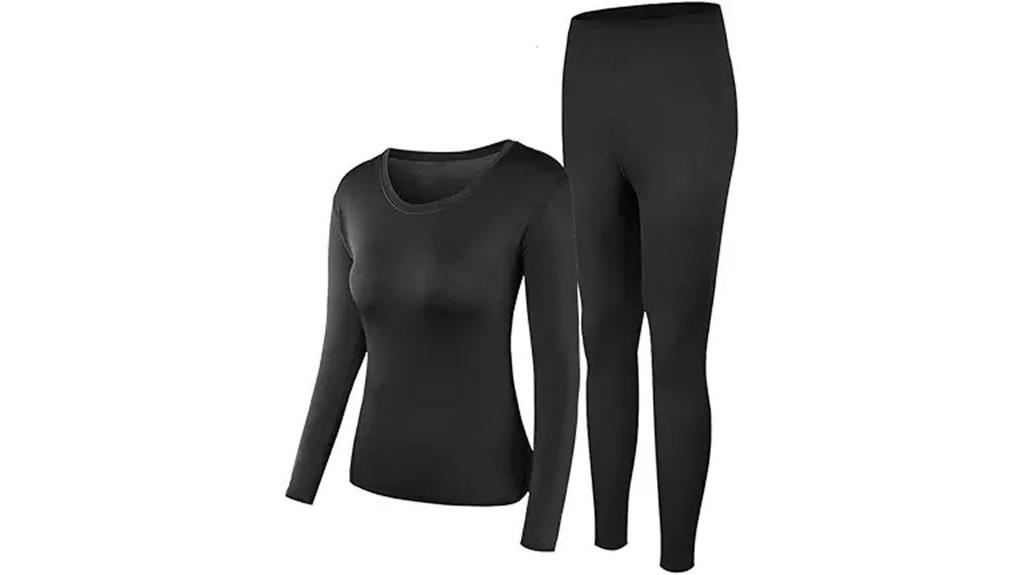
Women seeking reliable warmth during cold-weather hiking will find exceptional value in the PISIQI Thermal Underwear Women Ultra-Soft Long Johns Set, which consistently performs in extreme temperatures as low as -2°F. The ultra-soft fabric maintains comfort without restrictive tightness during extended trail activity. You’ll experience excellent stretch properties in the pants, though the tops may run small for curvier body types—consider ordering one size larger for ideal fit. The thermal set delivers superior durability through gentle wash cycles while retaining color integrity and resisting pilling. Multiple color options provide versatility for layering systems across diverse hiking conditions and seasonal requirements.
Best For: Women who need reliable thermal base layers for cold-weather hiking and outdoor activities in extreme temperatures.
Pros:
- Exceptional warmth performance in extreme cold conditions down to -2°F
- Ultra-soft, comfortable fabric with excellent stretch properties that doesn’t feel restrictive
- Durable construction that maintains color and resists pilling through multiple wash cycles
Cons:
- Tops may run small, especially for curvier body types, requiring sizing up
- Some reported issues with customer service and returns process
- Sizing inconsistency compared to other thermal underwear brands
Carhartt Mens MBL115 Base Force® Midweight Base Layer Classic Bottom
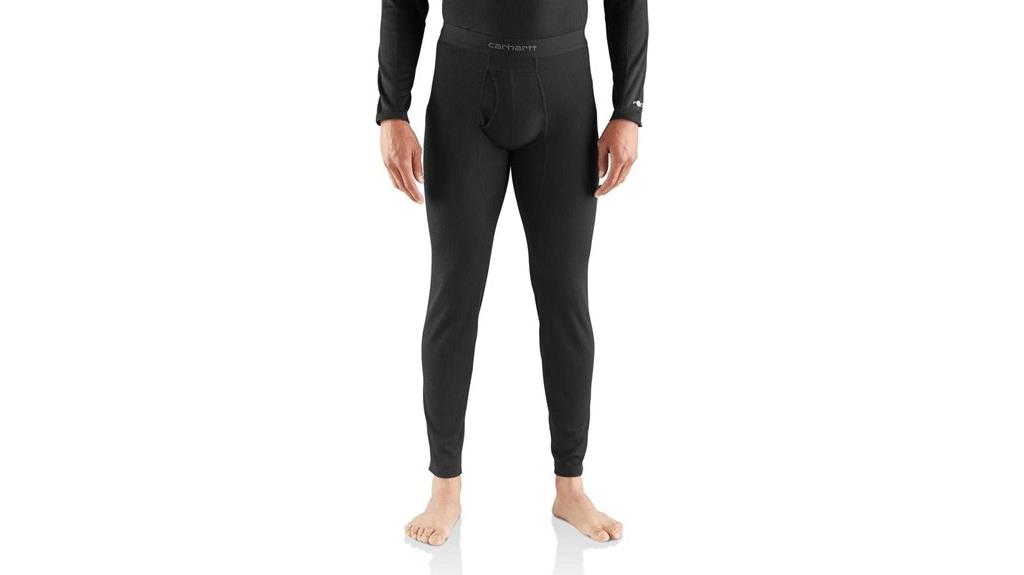
Serious hikers who push through harsh winter conditions will find the Carhartt Mens MBL115 Base Force® Midweight Base Layer Classic Bottom delivers exceptional thermal protection without bulk. The 200 GSM polyester construction with waffle knit fabric provides ideal insulation. FastDry technology actively wicks moisture away from your skin during intense activity. Rugged Flex technology guarantees unrestricted movement on challenging terrain.
You’ll appreciate the smooth flatlock seams that eliminate chafing during long hikes. The 33″ inseam accommodates most heights, though taller hikers might prefer additional length. Sizing runs tight, so consider ordering one size up. The odor-fighting fabric maintains freshness during multi-day adventures.
While the price point sits higher than budget alternatives, the quality justifies the investment for serious outdoor enthusiasts.
Best For: Serious hikers and outdoor enthusiasts who need reliable thermal protection and moisture-wicking performance during intense winter activities and multi-day adventures.
Pros:
- FastDry technology and odor-fighting fabric keep you dry and fresh during extended outdoor activities
- Rugged Flex technology and smooth flatlock seams provide unrestricted movement and eliminate chafing
- Durable 200 GSM polyester waffle knit construction offers excellent insulation without bulk
Cons:
- Higher price point compared to budget thermal underwear alternatives
- Sizing runs tight, requiring customers to order one size up from their normal size
- 33″ inseam may be too short for taller individuals who would prefer 34″ length
32 Degrees Mens Lightweight Baselayer Crew Top

Built-in 4-way stretch technology makes the 32 Degrees Mens Lightweight Baselayer Crew Top an ideal choice for hikers with broader builds who need unrestricted movement on the trail. The form-fitting design eliminates excess fabric while accommodating wide shoulders and large chest measurements.
This thermal base layer delivers warmth without bulk in temperatures as low as -20°C. You’ll maintain ideal body temperature without overheating during high-activity periods. The lightweight construction reduces pack weight while providing essential insulation.
The soft, smooth fabric construction offers superior comfort during extended wear. Users report excellent durability despite the lightweight design. This crew top performs effectively as your primary thermal layer, eliminating the need for heavy sweaters while hiking in cold conditions.
Best For: Hikers and outdoor enthusiasts with broader builds who need a lightweight, form-fitting thermal base layer that provides warmth without bulk in cold weather conditions.
Pros:
- 4-way stretch technology and form-fitting design accommodates wide shoulders and large chests while eliminating excess fabric
- Effective thermal insulation down to -20°C without causing overheating during high-activity periods
- Lightweight construction reduces pack weight while maintaining durability and superior comfort during extended wear
Cons:
- Higher price point that some customers consider expensive, especially with import fees
- Limited feedback available on long-term durability beyond general user reports
- May not provide sufficient warmth as a standalone layer in extremely cold conditions below -20°C
Iguana Mens 100% Merino Wool Base Layer Sets for Ski
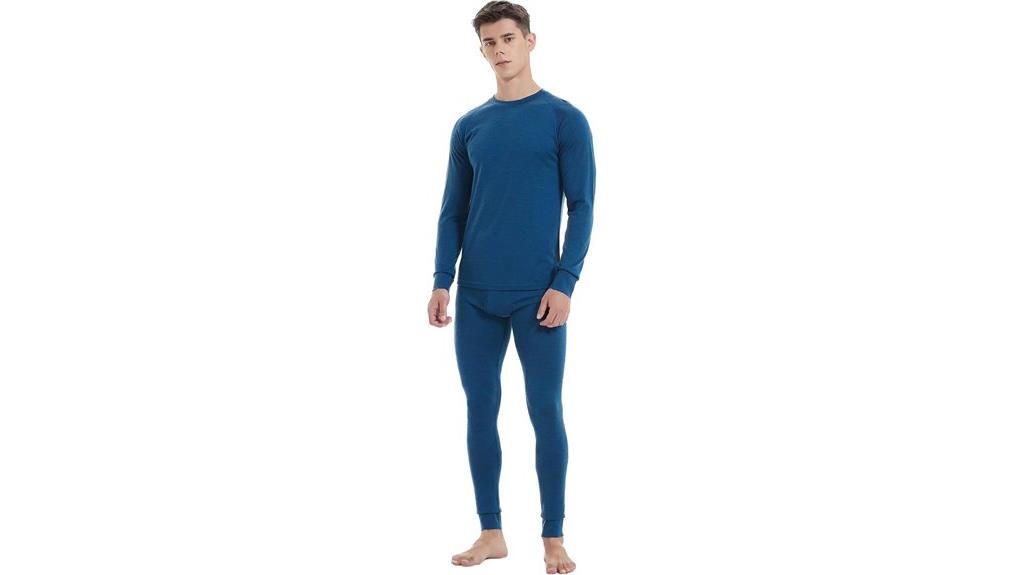
The Iguana Mens 100% Merino Wool Base Layer Set delivers exceptional warmth retention for skiers and winter sports enthusiasts who face extreme cold conditions. You’ll experience effective thermal regulation during activities like skiing and motorcycle rides, with proven performance at temperatures as low as -40°F. The merino wool construction provides superior warmth compared to synthetic alternatives.
You’ll find the fabric soft against your skin with minimal itching. The sizing runs true to fit—size Large accommodates users who are 5’10” and 185 pounds effectively, while taller individuals at 5’11” and 210 pounds find adequate length coverage. However, some quality concerns exist regarding authenticity, with reports of excessive static suggesting potential wool blends rather than pure merino construction.
Best For: Skiers and winter sports enthusiasts who need reliable warmth retention in extreme cold conditions down to -40°F and prefer natural merino wool over synthetic materials.
Pros:
- Exceptional warmth retention in extreme cold conditions with proven performance at -40°F
- Soft, comfortable fabric with minimal itching compared to other wool products
- True-to-size fit that accommodates various body types effectively
Cons:
- Quality concerns regarding authenticity of 100% merino wool construction
- Reports of excessive static suggesting potential wool blends rather than pure merino
- Some users still experience mild itching despite overall comfort
Factors to Consider When Choosing a Base Layer for Hiking
I’ll guide you through the essential factors that determine whether a base layer will perform well on your hiking adventures. The right base layer isn’t just about comfort – it’s about choosing materials, fit, and construction that match your specific hiking conditions and performance needs. Let’s examine the five critical elements you must evaluate: material composition, moisture management capabilities, proper sizing, temperature compatibility, and long-term durability.
Material and Fabric Type
When selecting a base layer for hiking, material choice directly determines your comfort and performance on the trail. Merino wool excels in moisture management with superior breathability and wicking properties. It regulates temperature effectively, keeping you warm in cold conditions while remaining cool in heat. The natural fiber’s softness reduces skin irritation during extended wear.
Synthetic materials like polyester offer enhanced durability and rapid drying capabilities. They’re ideal for high-intensity activities where sweat management is critical. However, consider the itch factor for long hikes—while Merino wool typically causes less irritation, quality synthetic options also provide comfortable wear.
Look for fabrics incorporating elastane for improved stretch and mobility. This flexibility accommodates the dynamic movements required during hiking while maintaining a secure, comfortable fit.
Moisture Wicking Properties
Moisture management stands as the most critical performance factor in base layer selection for hikers. Effective moisture-wicking fabrics draw sweat from your skin to the garment’s outer surface, where it evaporates quickly.
Merino wool excels through its natural fiber structure. It absorbs up to 30% of its weight in moisture without feeling wet against your skin. The wool’s crimped fibers create air pockets that regulate temperature while maintaining comfort.
Synthetic fabrics like polyester and nylon offer superior wicking speed. They move moisture faster than natural fibers and dry completely within minutes. Lightweight constructions under 150 GSM perform best during high-intensity activities.
Fabric maintenance affects long-term performance. I recommend washing with technical detergents and avoiding fabric softeners to preserve wicking capabilities over multiple seasons.
Fit and Sizing
Proper fit separates effective base layers from uncomfortable hiking experiences. I recommend choosing garments that provide a snug fit without restricting movement during dynamic activities. Your body dimensions determine proper sizing, though brand variations affect overall silhouette and fit consistency.
Stretchable materials accommodate hiking movements while maintaining secure positioning against your skin. These fabrics typically contain 10-20% elastane or spandex blended with merino wool or synthetic fibers. Consider upsizing certain styles if you’ll layer additional clothing over your base layer, especially for temperature regulation flexibility.
Well-fitted base layers trap heat effectively without creating excess bulk. The garment should feel like a second skin – tight enough to maintain thermal efficiency but loose enough to prevent circulation restriction. Test arm mobility and torso rotation before purchasing.
Temperature Range Suitability
Temperature ranges determine which base layer materials will perform effectively during your hiking adventures. I recommend lighter fabrics for temperatures above 40°F, while insulated options become essential below freezing. Merino wool excels across broad temperature spans due to superior moisture-wicking and thermoregulation properties. This natural fiber keeps you warm in cold conditions while preventing overheating during intense activity.
For freezing temperatures, I suggest fleece-lined or heavyweight polyester base layers that provide enhanced insulation compared to lightweight synthetics. Understand your destination’s weather patterns before selecting material weight. Many base layers operate efficiently within specific temperature thresholds. Lightweight fabrics can leave you chilled once movement stops, particularly in alpine environments. Choose materials that retain warmth without causing overheating during active periods.
Durability and Construction
Construction quality determines how long your base layer will withstand the rigors of extended hiking trips. Merino wool generally outperforms synthetic fabrics in durability testing, resisting wear and tear from repeated use. I recommend selecting garments with flatlock seams rather than standard stitching. These specialized seams lie flat against your skin, reducing chafing while strengthening stress points that typically fail first.
Tagless labels prevent irritation and eliminate a common failure point. Your base layer should fit snugly without being restrictive. Loose-fitting garments create excess friction during movement, accelerating fabric breakdown. Choose moisture-wicking, quick-drying materials to prevent prolonged sweat exposure that degrades fibers over time.
Always follow manufacturer care instructions precisely. Improper washing temperatures or aggressive drying cycles cause shrinkage and material breakdown that drastically reduces your investment’s lifespan.
Care and Maintenance
While selecting the right base layer material matters considerably, maintaining that investment through proper care practices directly impacts your gear’s performance and lifespan on the trail. I recommend washing your base layer after every hike, especially following strenuous activities, to prevent odor retention and maintain hygiene standards.
Follow manufacturer care instructions precisely. Most base layers require handwashing or delicate cycle settings in cold water to protect synthetic fibers and merino wool construction. Never use fabric softeners, as they’ll compromise moisture-wicking properties.
Air dry on hangers instead of machine drying. Heat damages technical fabrics and causes shrinkage that affects fit and performance. I inspect my base layers regularly for pilling, loose threads, or stretched areas. These wear indicators signal when replacement becomes necessary for ideal trail performance.
On a final note
I’ve analyzed the top-performing base layers across different price points and materials. Merino wool options like MERIWOOL provide superior odor resistance and temperature regulation. Synthetic alternatives like 32 Degrees offer faster drying times at lower costs. Your choice depends on trip duration, weather conditions, and budget. Consider fabric blend, fit, and intended use when selecting. Test your base layer system before long hikes to guarantee peak comfort and performance.


